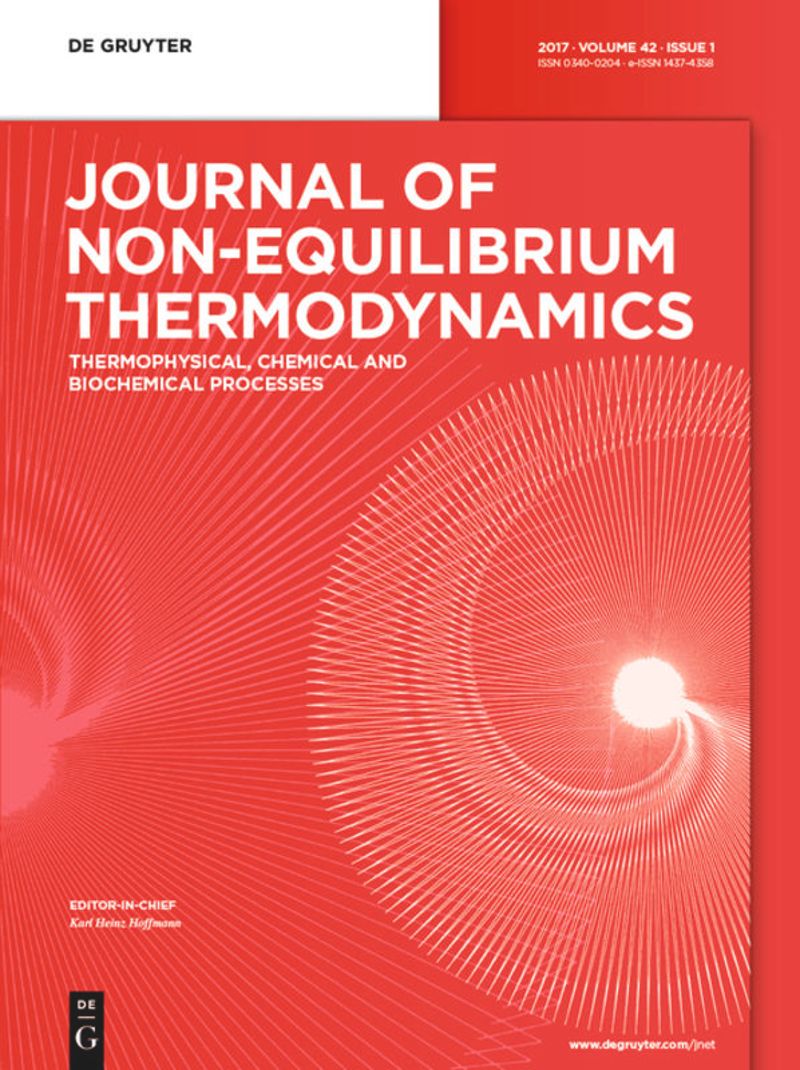定常和非定常泊泽维尔流的内能与状态参数的关系
IF 4.2
3区 工程技术
Q1 MECHANICS
引用次数: 0
摘要
我们研究了理想气体在稳定和非稳定状态下的平面可压缩泊泽维尔流,以确定描述内能变化所需的最小状态参数。在以前的工作中(物理学)。Rev. E 104, 055107(2021)),稳定流动需要五个参数。在这里,使用全局非平衡热力学,我们将这个数字减少到三个:非平衡熵S *、体积V和粒子数N。这种系统在平稳和非平稳状态下的内能U(S *, V, N)是系统中非平衡熵S *、体积V和粒子数N的函数,与任何过程、边界条件的数量或强加的约束无关。我们通过在通道内放置一个圆柱体来测试这一点,发现U仅通过V = const的状态参数S *(y c)和N(y c)取决于圆柱体的位置y c。此外,在流动变得不稳定,速度、压力等参数振荡的情况下,当V = const时,U仅通过S *(t)和N(t)依赖于时间t。这些结果表明,即使在具有不同边界条件的非定常流动中,这种内能公式仍然是稳健和一致的。本文章由计算机程序翻译,如有差异,请以英文原文为准。
The internal energy as a function of state parameters in steady and unsteady Poiseuille flows
We studied planar compressible Poiseuille flows of an ideal gas, both in steady and unsteady states, to identify the minimal number of state parameters required to describe changes in internal energy. In previous work (Phys. Rev. E 104, 055107 (2021)), five parameters were needed for steady flows. Here, using global non-equilibrium thermodynamics, we reduce this number to three: non-equilibrium entropy S * , volume V , and number of particles N . The internal energy U (S * , V , N ) of such systems in stationary and non-stationary states is the function of non-equilibrium entropy S * , volume V and number of particles N in the system irrespective of any processes, number of boundary conditions or imposed constraints. We tested this by placing a cylinder inside the channel, finding that U depends on the cylinder’s location y c only via the state parameters S * (y c ) and N (y c ) for V = const. Moreover, in cases where the flow becomes unstable and parameters such as velocity and pressure oscillate, U depends on time t only through S * (t ) and N (t ) for V = const. These results demonstrate that this formulation of internal energy remains robust and consistent, even in unsteady flows with varying boundary conditions.
求助全文
通过发布文献求助,成功后即可免费获取论文全文。
去求助
来源期刊
CiteScore
9.10
自引率
18.20%
发文量
31
审稿时长
1 months
期刊介绍:
The Journal of Non-Equilibrium Thermodynamics serves as an international publication organ for new ideas, insights and results on non-equilibrium phenomena in science, engineering and related natural systems. The central aim of the journal is to provide a bridge between science and engineering and to promote scientific exchange on a) newly observed non-equilibrium phenomena, b) analytic or numeric modeling for their interpretation, c) vanguard methods to describe non-equilibrium phenomena.
Contributions should – among others – present novel approaches to analyzing, modeling and optimizing processes of engineering relevance such as transport processes of mass, momentum and energy, separation of fluid phases, reproduction of living cells, or energy conversion. The journal is particularly interested in contributions which add to the basic understanding of non-equilibrium phenomena in science and engineering, with systems of interest ranging from the macro- to the nano-level.
The Journal of Non-Equilibrium Thermodynamics has recently expanded its scope to place new emphasis on theoretical and experimental investigations of non-equilibrium phenomena in thermophysical, chemical, biochemical and abstract model systems of engineering relevance. We are therefore pleased to invite submissions which present newly observed non-equilibrium phenomena, analytic or fuzzy models for their interpretation, or new methods for their description.

 求助内容:
求助内容: 应助结果提醒方式:
应助结果提醒方式:


